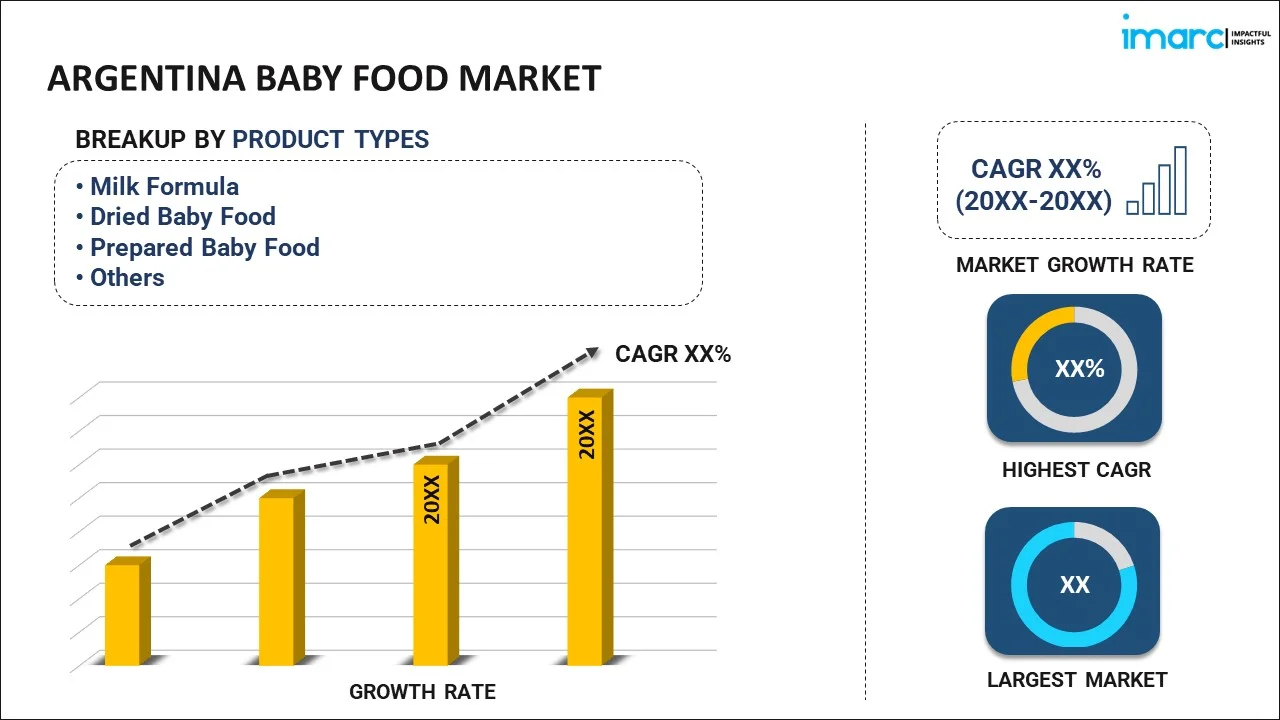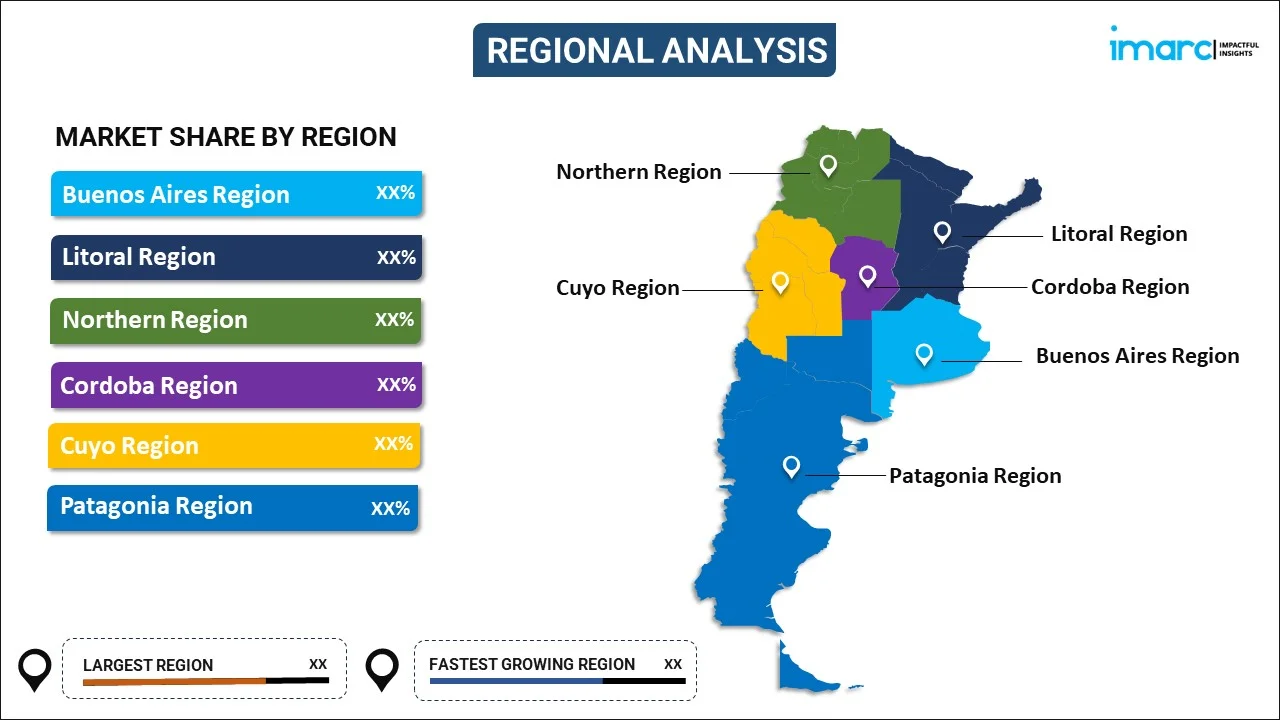
Argentina Baby Food Market Report by Product Type (Milk Formula, Dried Baby Food, Prepared Baby Food, and Others), Age Group (0-6 Months, 6-12 Months, 12-24 Months), Distribution Channel (Supermarkets/Hypermarkets, Online, Pharmacies, Convenience Stores, and Others), and Region 2024-2032
Argentina Baby Food Market Overview:
The Argentina baby food market size reached US$ 409.5 Million in 2023. Looking forward, IMARC Group expects the market to reach US$ 793 Million by 2032, exhibiting a growth rate (CAGR) of 7.80% during 2024-2032. The market is propelled by the rapid urbanization and changing lifestyles, increasing health awareness among parents, favorable government initiatives and support programs, inflating disposable income levels, and increasing hectic population.
|
Report Attribute
|
Key Statistics
|
|---|---|
|
Base Year
|
2023 |
|
Forecast Years
|
2024-2032 |
|
Historical Years
|
2018-2023
|
| Market Size in 2023 | US$ 409.5 Million |
| Market Forecast in 2032 | US$ 793 Million |
| Market Growth Rate (2024-2032) | 7.80% |
Argentina Baby Food Market Trends:
Rapidly Increasing Urbanization and Changing Lifestyles
Urbanization in Argentina has been on a consistent upward trajectory, fundamentally transforming family structures and daily lifestyles. According to the INTERNATIONAL TRADE ADMINISTRATION, Argentina has approximately 92% of the population residing in urban areas. As more individuals migrate to urban areas, there is a marked increase in dual-income households where both parents hold full-time jobs. This shift has significantly heightened the demand for convenient, ready-to-eat baby food products that cater to the time constraints and busy schedules of working parents. In bustling urban environments, the accessibility of supermarkets and retail stores is notably more straightforward, facilitating the purchase of packaged baby food. This convenience is a crucial factor for urban families who find it challenging to prepare homemade meals amidst their hectic routines. The urban landscape, with its robust infrastructure and retail presence, thus supports and accelerates the trend toward ready-made baby food solutions, aligning perfectly with the evolving needs of modern Argentine families.
Increasing Health Awareness Among Parents
In Argentina, a rising awareness among parents regarding the nutritional needs of their infants has sparked a significant shift toward healthier dietary choices for their children. This growing consciousness is reflected in the increasing preference for organic and fortified baby food products that ensure the inclusion of essential nutrients in the diets of the children. Responding to this trend, manufacturers are expanding their offerings to include a wider variety of baby food products free from artificial additives, preservatives, and GMOs. These products often emphasize natural and organic ingredients, catering to the demands of health-conscious parents who prioritize the well-being of their infants. Willing to invest in premium-quality options, these parents are driving the market toward more transparent and wholesome baby food choices, fostering a new era of infant nutrition in Argentina.
Favorable Government Initiatives and Support Programs
The Argentine government has undertaken a comprehensive approach to improving child nutrition and addressing malnutrition rates among infants through various initiatives and support programs. Central to these efforts are educational campaigns designed to raise awareness among parents about the critical importance of proper nutrition during the early developmental stages of life. These campaigns provide valuable information on the benefits of balanced diets, the risks of malnutrition, and the positive impact of nutrient-rich foods on infant health and growth. In addition to education, the government provides subsidies and financial support to low-income families, ensuring that nutritious baby food is more accessible to all segments of the population. This multifaceted strategy enhances the market for baby food products by increasing demand and also motivates manufacturers to innovate and produce healthier, more nutrient-dense options.
Argentina Baby Food Market News:
- October 9, 2023: A division of Danish dairy giant Arla Foods is investing in an existing factory in Argentina facility for proteins and infant-formula applications. It plans to add a new drying tower to the site in the city of Porteña that is set to be completed in 2026. This will result in “more than double” production of so-called permeate powder, a high-lactose ingredient produced through the removal of proteins from milk for use by food manufacturers. Arla Foods said the Porteña plant upgrade is intended to cater to the “growing demand for high-quality whey ingredients both in Latin America and globally” and has also been given approval to produce dairy proteins for infant-formula products.
Argentina Baby Food Market Segmentation:
IMARC Group provides an analysis of the key trends in each segment of the market, along with forecasts at the country level for 2024-2032. Our report has categorized the market based on product type, age group, and distribution channel.
Product Type Insights:

- Milk Formula
- Dried Baby Food
- Prepared Baby Food
- Others
The report has provided a detailed breakup and analysis of the market based on the product type. This includes milk formula, dried baby food, prepared baby food, and others.
Age Group Insights:
- 0-6 Months
- 6-12 Months
- 12-24 Months
A detailed breakup and analysis of the market based on the age group have also been provided in the report. This includes 0-6 months, 6-12 months, and 12-24 months.
Distribution Channel Insights:
- Supermarkets/Hypermarkets
- Online
- Pharmacies
- Convenience Stores
- Others
The report has provided a detailed breakup and analysis of the market based on the distribution channel. This includes supermarkets and hypermarkets, online, pharmacies, convenience stores, and others.
Regional Insights:

- Buenos Aires Region
- Litoral Region
- Northern Region
- Cordoba Region
- Cuyo Region
- Patagonia Region
The report has also provided a comprehensive analysis of all the major regional markets, which include Buenos Aires Region, Litoral Region, Northern Region, Cordoba Region, Cuyo Region, and Patagonia Region.
Competitive Landscape:
The market research report has also provided a comprehensive analysis of the competitive landscape. Competitive analysis such as market structure, key player positioning, top winning strategies, competitive dashboard, and company evaluation quadrant has been covered in the report. Also, detailed profiles of all major companies have been provided.
Argentina Baby Food Market Report Coverage:
| Report Features | Details |
|---|---|
| Base Year of the Analysis | 2023 |
| Historical Period | 2018-2023 |
| Forecast Period | 2024-2032 |
| Units | Million US$ |
| Scope of the Report | Exploration of Historical and Forecast Trends, Industry Catalysts and Challenges, Segment-Wise Historical and Predictive Market Assessment:
|
| Product Types Covered | Milk Formula, Dried Baby Food, Prepared Baby Food, Others |
| Age Groups Covered | 0-6 Months, 6-12 Months, 12-24 Months |
| Distribution Channels Covered | Supermarkets and Hypermarkets, Online, Pharmacies, Convenience Stores, Others |
| Regions Covered | Buenos Aires Region, Litoral Region, Northern Region, Cordoba Region, Cuyo Region, Patagonia Region |
| Customization Scope | 10% Free Customization |
| Post-Sale Analyst Support | 10-12 Weeks |
| Delivery Format | PDF and Excel through Email (We can also provide the editable version of the report in PPT/Word format on special request) |
Key Questions Answered in This Report:
- How has the Argentina baby food market performed so far and how will it perform in the coming years?
- What has been the impact of COVID-19 on the Argentina baby food market?
- What is the breakup of the Argentina baby food market on the basis of product type?
- What is the breakup of the Argentina baby food market on the basis of age group?
- What is the breakup of the Argentina baby food market on the basis of distribution channel?
- What are the various stages in the value chain of the Argentina baby food market?
- What are the key driving factors and challenges in the Argentina baby food?
- What is the structure of the Argentina baby food market and who are the key players?
- What is the degree of competition in the Argentina baby food market?
Key Benefits for Stakeholders:
- IMARC’s industry report offers a comprehensive quantitative analysis of various market segments, historical and current market trends, market forecasts, and dynamics of the Argentina baby food market from 2018-2032.
- The research report provides the latest information on the market drivers, challenges, and opportunities in the Argentina baby food market.
- Porter's five forces analysis assist stakeholders in assessing the impact of new entrants, competitive rivalry, supplier power, buyer power, and the threat of substitution. It helps stakeholders to analyze the level of competition within the Argentina baby food industry and its attractiveness.
- Competitive landscape allows stakeholders to understand their competitive environment and provides an insight into the current positions of key players in the market.
Need more help?
- Speak to our experienced analysts for insights on the current market scenarios.
- Include additional segments and countries to customize the report as per your requirement.
- Gain an unparalleled competitive advantage in your domain by understanding how to utilize the report and positively impacting your operations and revenue.
- For further assistance, please connect with our analysts.
 Inquire Before Buying
Inquire Before Buying
 Speak to an Analyst
Speak to an Analyst
 Request Brochure
Request Brochure
 Request Customization
Request Customization




.webp)




.webp)












